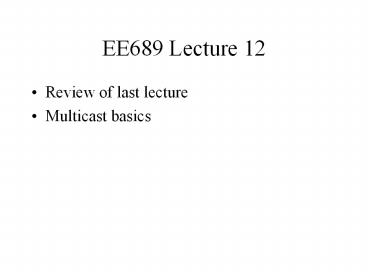EE689 Lecture 12 - PowerPoint PPT Presentation
1 / 20
Title:
EE689 Lecture 12
Description:
Title: EE689 Lecture 12 Author: Steven Woodward Last modified by: Steven Woodward Created Date: 2/24/1999 2:34:08 PM Document presentation format – PowerPoint PPT presentation
Number of Views:177
Avg rating:3.0/5.0
Title: EE689 Lecture 12
1
EE689 Lecture 12
- Review of last lecture
- Multicast basics
2
Multicast -motivation
- Point-to-point delivery not efficient for
events/transmissions of general interest - Examples
- News multicast
- IETF sessions/rock concerts
- Many receivers may share the same path
- Point-to-point delivery too expensive
3
Multicast motivation
4
Multicast issues
- In point-to-point delivery, receiver address is
known gt routing is straightforward - In Multicast, many receivers
- How to transmit data to all the receivers?
- How to identify the group of receivers?
- At the sender?
- In the network?
5
Multicast issues
- Identify multicast by a group/multicast address
- The membership changes as the receivers
join/leave the group - Routers/Network need to recognize the multicast
address - Receivers need to receive on their own IP address
and on the multicast address
6
Multicast routing
- For point-to-point delivery, a router looks up
routing table and knows how to forward - For multicast, many receivers
- may have to forward packets on multiple outgoing
links - too hard to keep track of individual receivers at
each router for each multicast group - remember just the links on which to be forwarded
- change as receivers join/leave
7
Multicast addressing
- A multicast sender uses the group address as the
receivers address when sending packets - Network/routers keep track of actual receiving
subnets/paths for this group address (not the
actual receivers) - Receivers can reply to senders address or to
group address
8
Multicast addressing
- Part of IP address space reserved for multicast
- Multicast routers recognize multicast addresses
- Need to get a multicast address for a
transmission before multicast can start - Protocols exist for obtaining multicast addresses
and finding out a multicast address
9
Class D addresses
- High order 4 bits 1110, followed by a 28-bit
multicast group ID. 224.0.0.0 - 239.255.255.255 - 224.0.0.1 - all systems on this subnet
- 224.0.0.2 - all routers on this subnet
- 224.0.0.4 - all DVMRP routers
- 224.0.0.5 - all OSPF routers
10
Multicasting
- The end routers use physical layer multicasting
to multicast packets to multiple receivers on the
same subnet - IP-multicast group ID copied into the MAC-layer
multicast address - All receivers of this group listen to this
multicast address to receive packets
11
IGMP
- Internet Group Membership Protocol
- Used to join a multicast group and to check on
the current status of receivers on a subnet - IGMP -join message propagated up the routers
until the multicast tree reached. - Routers periodically poll hosts on subnets to see
if any active receivers remain
12
IGMP
- If no active receivers remain, routers propagate
leave messages upstream to reduce unnecessary
traffic - Frequent polling can increase overhead
- Separate protocols for finding group membership
address - sd
13
IGMP version 3
- Allows sender-specific reports when multiple
senders are in a multicast group - Can exclude certain senders and allow certain
senders - allows better bandwidth management in
multi-sender multicasts.
14
Mbone
- Multicast Backbone
- Consists of all the multicast-enabled routers
- If two multicast routers are not directly
connected, uses tunneling over non-multicast
routers - Allows gradual deployment
15
Multicast routing
- Need to recognize multicast addresses
- The routing tables change as the receivers
join/leave a multicast group - Every router keeps track of downstream links on
which to forward a packet - Routing table and multicast address expire at
the end of session
16
Multicast routing
- Many possible approaches
- Flooding
- send on all links to reach the receivers
- not efficient
- Spanning tree
- efficient
- could concentrate traffic on a few links
17
Routing
- Spanning trees rooted at the sender
- Sender sends out a broadcast over the entire
network - all routers get at least one packet - When receivers want to join, routers employ
Reverse Path Multicasting - Use Pruning to limit the multicast transmission.
18
Routing
- DVMRP - Distance Vector Multicast
- MOSPF - Multicast Extensions to OSPF
- PIM - Protocol Independent Multicast
19
Routing
- Spanning trees rooted at the sender
- When a receiver wants to join a group, may have
to broadcast on all upstream links to find a path
to the sender - could cause a lot of overhead in sparse groups
- need better solutions
20
Sparse Mode routing
- Use a Core-based tree (CBT)
- Use a rendezvous point or a core router
- Direct all joins to RP which knows how to reach
the sender - can avoid broadcasting multicast group
information to all routers in the network - can result in non-optimal paths
- would need to modify multicast tree over time































